介词[上学期]
图片预览
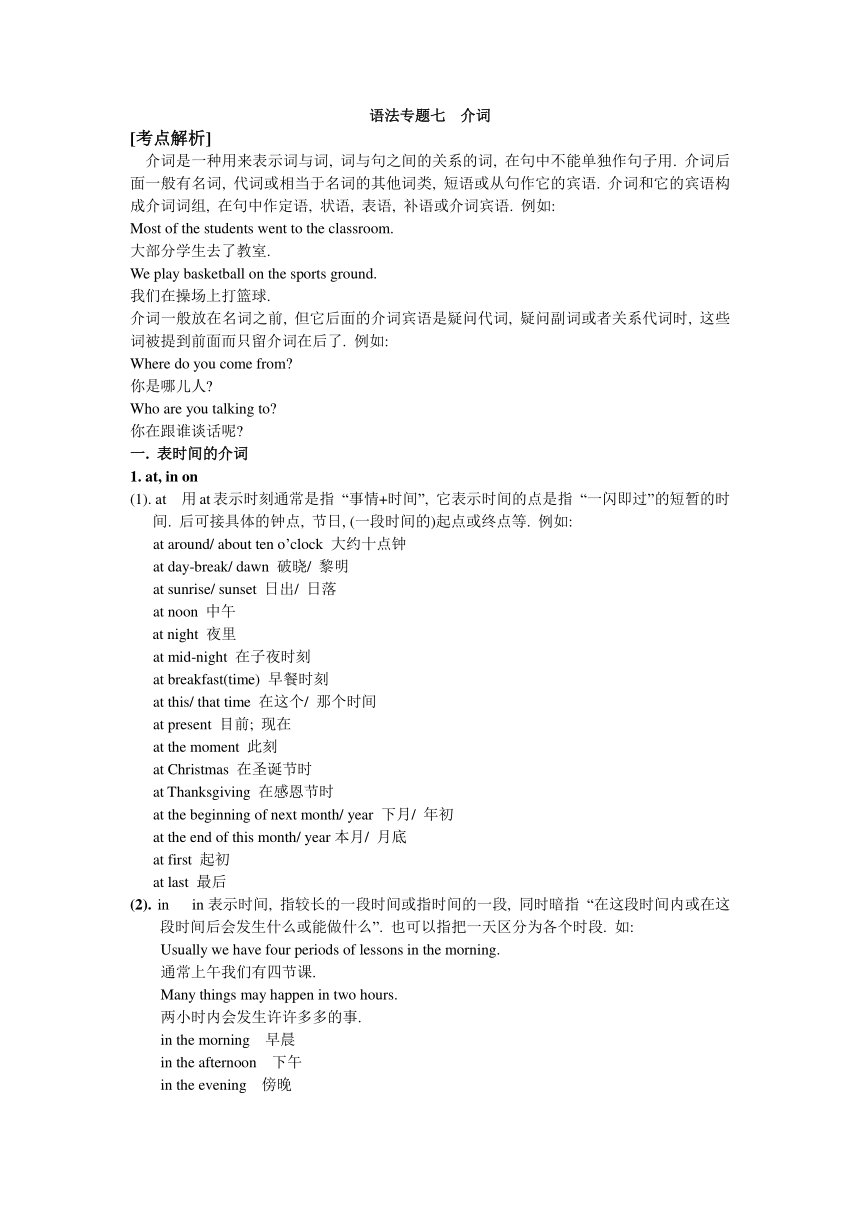
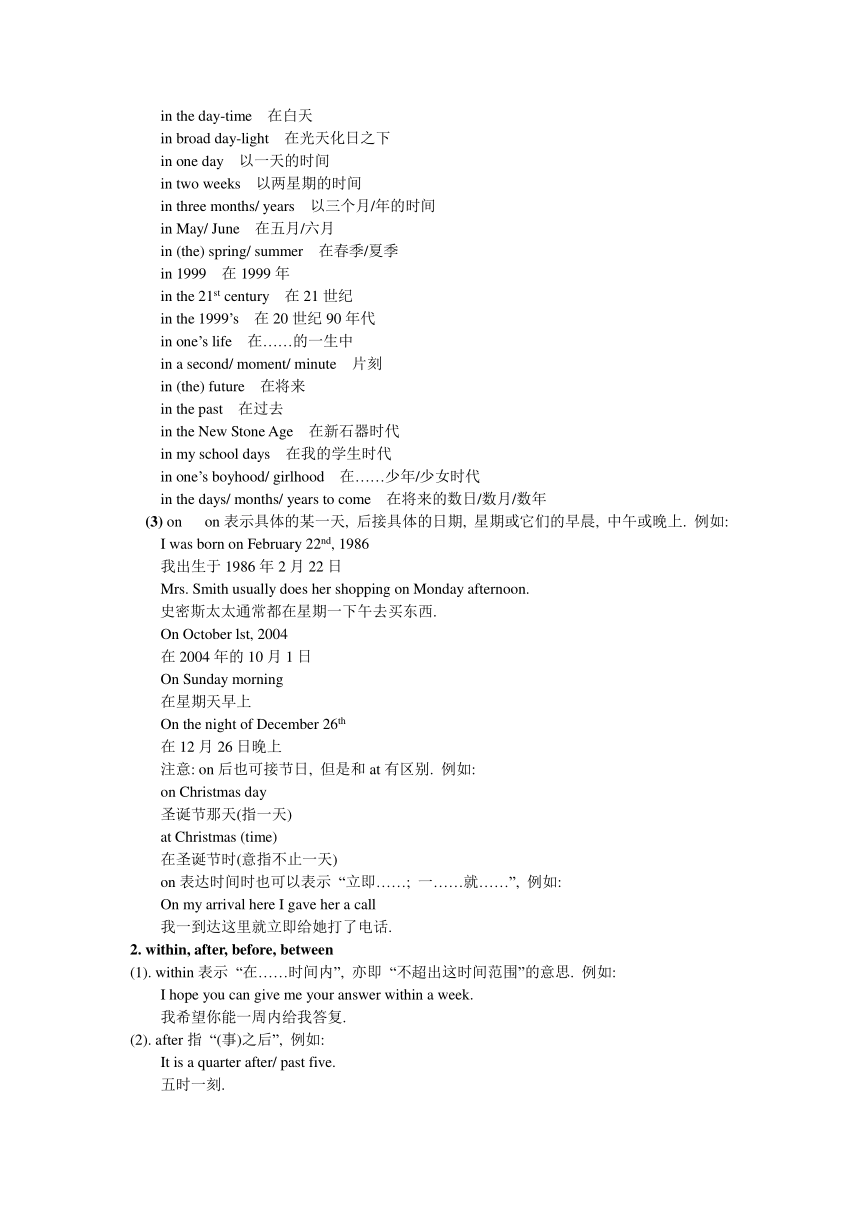
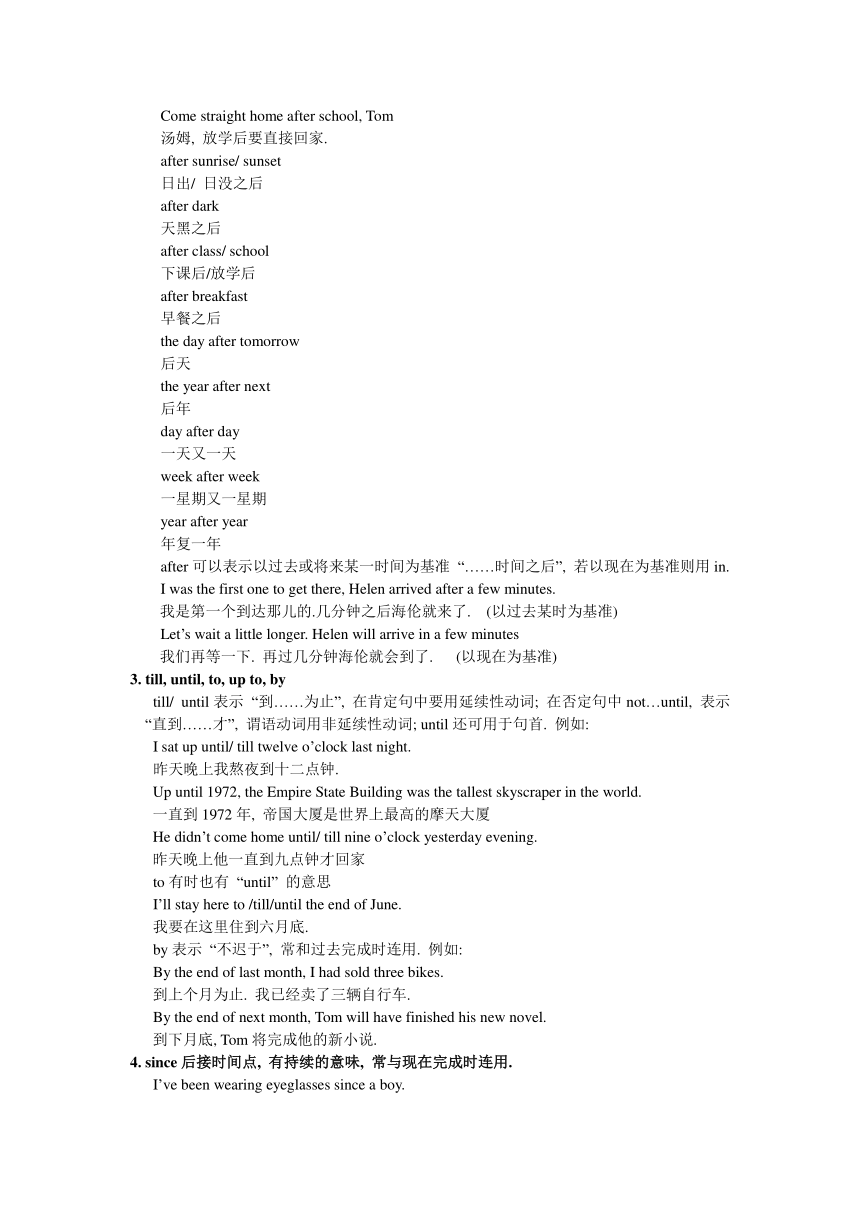
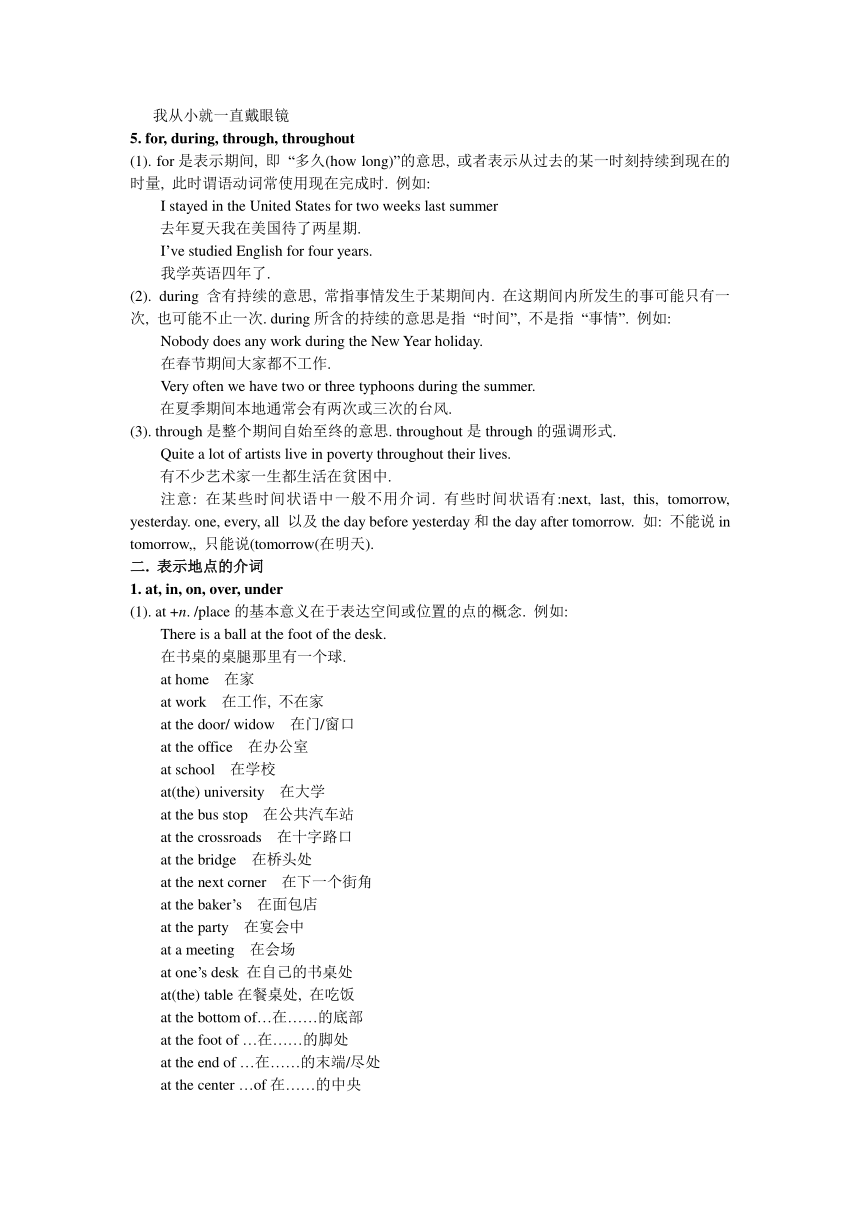
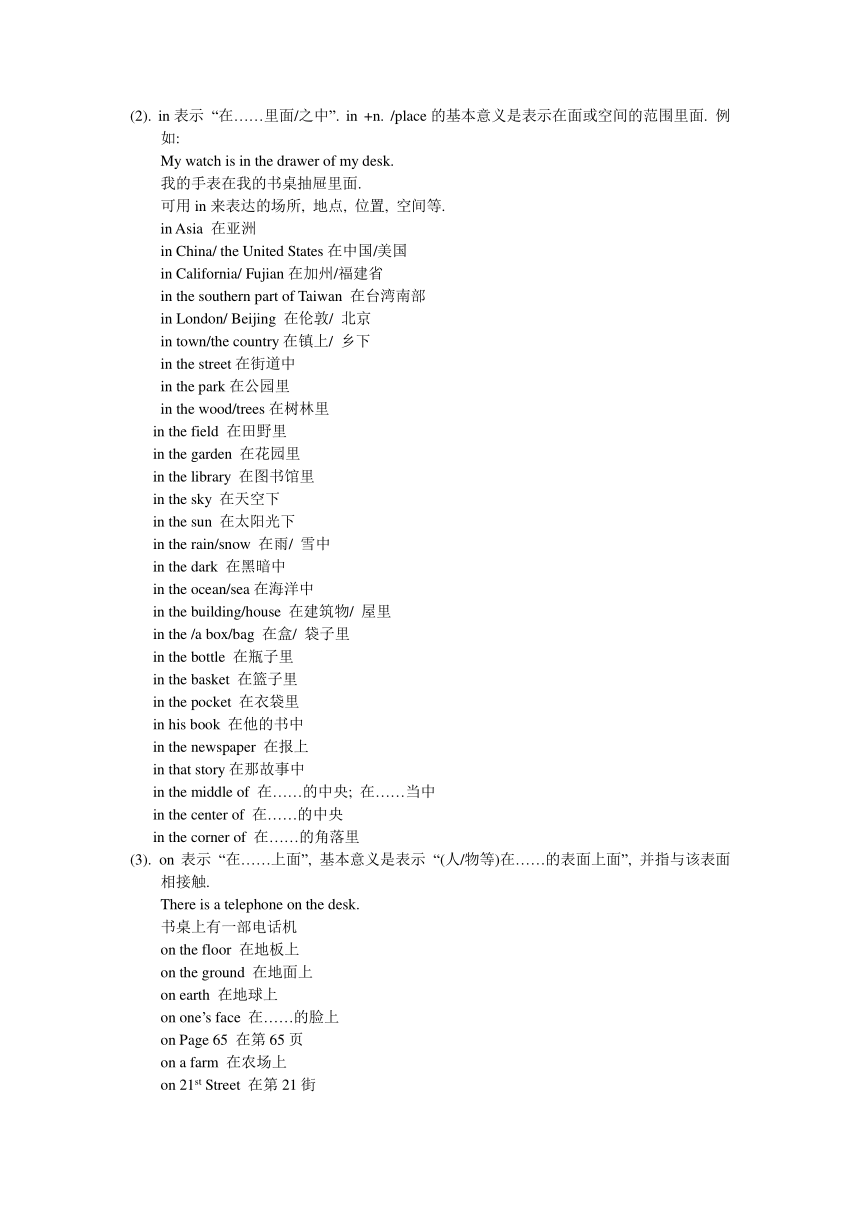
文档简介
语法专题七 介词
[考点解析]
介词是一种用来表示词与词, 词与句之间的关系的词, 在句中不能单独作句子用. 介词后面一般有名词, 代词或相当于名词的其他词类, 短语或从句作它的宾语. 介词和它的宾语构成介词词组, 在句中作定语, 状语, 表语, 补语或介词宾语. 例如:
Most of the students went to the classroom.
大部分学生去了教室.
We play basketball on the sports ground.
我们在操场上打篮球.
介词一般放在名词之前, 但它后面的介词宾语是疑问代词, 疑问副词或者关系代词时, 这些词被提到前面而只留介词在后了. 例如:
Where do you come from
你是哪儿人
Who are you talking to
你在跟谁谈话呢
1. 表时间的介词
1. at, in on
(1). at 用at表示时刻通常是指 “事情+时间”, 它表示时间的点是指 “一闪即过”的短暂的时间. 后可接具体的钟点, 节日, (一段时间的)起点或终点等. 例如:
at around/ about ten o’clock 大约十点钟
at day-break/ dawn 破晓/ 黎明
at sunrise/ sunset 日出/ 日落
at noon 中午
at night 夜里
at mid-night 在子夜时刻
at breakfast(time) 早餐时刻
at this/ that time 在这个/ 那个时间
at present 目前; 现在
at the moment 此刻
at Christmas 在圣诞节时
at Thanksgiving 在感恩节时
at the beginning of next month/ year 下月/ 年初
at the end of this month/ year本月/ 月底
at first 起初
at last 最后
(2). in in表示时间, 指较长的一段时间或指时间的一段, 同时暗指 “在这段时间内或在这段时间后会发生什么或能做什么”. 也可以指把一天区分为各个时段. 如:
Usually we have four periods of lessons in the morning.
通常上午我们有四节课.
Many things may happen in two hours.
两小时内会发生许许多多的事.
in the morning 早晨
in the afternoon 下午
in the evening 傍晚
in the day-time 在白天
in broad day-light 在光天化日之下
in one day 以一天的时间
in two weeks 以两星期的时间
in three months/ years 以三个月/年的时间
in May/ June 在五月/六月
in (the) spring/ summer 在春季/夏季
in 1999 在1999年
in the 21st century 在21世纪
in the 1999’s 在20世纪90年代
in one’s life 在……的一生中
in a second/ moment/ minute 片刻
in (the) future 在将来
in the past 在过去
in the New Stone Age 在新石器时代
in my school days 在我的学生时代
in one’s boyhood/ girlhood 在……少年/少女时代
in the days/ months/ years to come 在将来的数日/数月/数年
(3) on on表示具体的某一天, 后接具体的日期, 星期或它们的早晨, 中午或晚上. 例如:
I was born on February 22nd, 1986
我出生于1986年2月22日
Mrs. Smith usually does her shopping on Monday afternoon.
史密斯太太通常都在星期一下午去买东西.
On October lst, 2004
在2004年的10月1日
On Sunday morning
在星期天早上
On the night of December 26th
在12月26日晚上
注意: on后也可接节日, 但是和at有区别. 例如:
on Christmas day
圣诞节那天(指一天)
at Christmas (time)
在圣诞节时(意指不止一天)
on表达时间时也可以表示 “立即……; 一……就……”, 例如:
On my arrival here I gave her a call
我一到达这里就立即给她打了电话.
2. within, after, before, between
(1). within表示 “在……时间内”, 亦即 “不超出这时间范围”的意思. 例如:
I hope you can give me your answer within a week.
我希望你能一周内给我答复.
(2). after指 “(事)之后”, 例如:
It is a quarter after/ past five.
五时一刻.
Come straight home after school, Tom
汤姆, 放学后要直接回家.
after sunrise/ sunset
日出/ 日没之后
after dark
天黑之后
after class/ school
下课后/放学后
after breakfast
早餐之后
the day after tomorrow
后天
the year after next
后年
day after day
一天又一天
week after week
一星期又一星期
year after year
年复一年
after可以表示以过去或将来某一时间为基准 “……时间之后”, 若以现在为基准则用in.
I was the first one to get there, Helen arrived after a few minutes.
我是第一个到达那儿的.几分钟之后海伦就来了. (以过去某时为基准)
Let’s wait a little longer. Helen will arrive in a few minutes
我们再等一下. 再过几分钟海伦就会到了. (以现在为基准)
3. till, until, to, up to, by
till/ until表示 “到……为止”, 在肯定句中要用延续性动词; 在否定句中not…until, 表示 “直到……才”, 谓语动词用非延续性动词; until还可用于句首. 例如:
I sat up until/ till twelve o’clock last night.
昨天晚上我熬夜到十二点钟.
Up until 1972, the Empire State Building was the tallest skyscraper in the world.
一直到1972年, 帝国大厦是世界上最高的摩天大厦
He didn’t come home until/ till nine o’clock yesterday evening.
昨天晚上他一直到九点钟才回家
to有时也有 “until” 的意思
I’ll stay here to /till/until the end of June.
我要在这里住到六月底.
by表示 “不迟于”, 常和过去完成时连用. 例如:
By the end of last month, I had sold three bikes.
到上个月为止. 我已经卖了三辆自行车.
By the end of next month, Tom will have finished his new novel.
到下月底, Tom将完成他的新小说.
4. since后接时间点, 有持续的意味, 常与现在完成时连用.
I’ve been wearing eyeglasses since a boy.
我从小就一直戴眼镜
5. for, during, through, throughout
(1). for是表示期间, 即 “多久(how long)”的意思, 或者表示从过去的某一时刻持续到现在的时量, 此时谓语动词常使用现在完成时. 例如:
I stayed in the United States for two weeks last summer
去年夏天我在美国待了两星期.
I’ve studied English for four years.
我学英语四年了.
(2). during含有持续的意思, 常指事情发生于某期间内. 在这期间内所发生的事可能只有一次, 也可能不止一次. during所含的持续的意思是指 “时间”, 不是指 “事情”. 例如:
Nobody does any work during the New Year holiday.
在春节期间大家都不工作.
Very often we have two or three typhoons during the summer.
在夏季期间本地通常会有两次或三次的台风.
(3). through是整个期间自始至终的意思. throughout是through的强调形式.
Quite a lot of artists live in poverty throughout their lives.
有不少艺术家一生都生活在贫困中.
注意: 在某些时间状语中一般不用介词. 有些时间状语有:next, last, this, tomorrow, yesterday. one, every, all 以及the day before yesterday和the day after tomorrow. 如: 不能说in tomorrow,, 只能说(tomorrow(在明天).
2. 表示地点的介词
1. at, in, on, over, under
(1). at +n. /place的基本意义在于表达空间或位置的点的概念. 例如:
There is a ball at the foot of the desk.
在书桌的桌腿那里有一个球.
at home 在家
at work 在工作, 不在家
at the door/ widow 在门/窗口
at the office 在办公室
at school 在学校
at(the) university 在大学
at the bus stop 在公共汽车站
at the crossroads 在十字路口
at the bridge 在桥头处
at the next corner 在下一个街角
at the baker’s 在面包店
at the party 在宴会中
at a meeting 在会场
at one’s desk 在自己的书桌处
at(the) table在餐桌处, 在吃饭
at the bottom of…在……的底部
at the foot of …在……的脚处
at the end of …在……的末端/尽处
at the center …of在……的中央
(2). in表示 “在……里面/之中”. in +n. /place的基本意义是表示在面或空间的范围里面. 例如:
My watch is in the drawer of my desk.
我的手表在我的书桌抽屉里面.
可用in来表达的场所, 地点, 位置, 空间等.
in Asia 在亚洲
in China/ the United States在中国/美国
in California/ Fujian在加州/福建省
in the southern part of Taiwan 在台湾南部
in London/ Beijing 在伦敦/ 北京
in town/the country在镇上/ 乡下
in the street在街道中
in the park在公园里
in the wood/trees在树林里
in the field 在田野里
in the garden 在花园里
in the library 在图书馆里
in the sky 在天空下
in the sun 在太阳光下
in the rain/snow 在雨/ 雪中
in the dark 在黑暗中
in the ocean/sea在海洋中
in the building/house 在建筑物/ 屋里
in the /a box/bag 在盒/ 袋子里
in the bottle 在瓶子里
in the basket 在篮子里
in the pocket 在衣袋里
in his book 在他的书中
in the newspaper 在报上
in that story在那故事中
in the middle of 在……的中央; 在……当中
in the center of 在……的中央
in the corner of 在……的角落里
(3). on表示 “在……上面”, 基本意义是表示 “(人/物等)在……的表面上面”, 并指与该表面相接触.
There is a telephone on the desk.
书桌上有一部电话机
on the floor 在地板上
on the ground 在地面上
on earth 在地球上
on one’s face 在……的脸上
on Page 65 在第65页
on a farm 在农场上
on 21st Street 在第21街
on the Mississippi River 在密西西比河边
(4). over表示 “在……的上方或覆于……的上面”, 是under的相反词. 其意义是 “在……平面或物体的上方”, 所以只要是在一个水平的表面, 或有面积的平面上方就可用over, 不必在垂直的上方. 例如:
There is a light on the desk.
书桌的上方有一盏灯
She put her hands over her face.
她用两手遮住了她的脸.
We saw our national flag flying over the roof.
我们看到了国旗在屋顶上飘扬.
注: on与over的区别.
on是 “support(支撑)”的意思, over则是 “cover(覆盖)”的意思.
I put a cup on the desk.
我把一个杯放在桌上. (书桌支撑着杯子).
Then I put my handkerchief over the cup.
然后我把我的手帕盖在杯子上. (杯子被手帕所覆盖).
(5). under表示 “在……的下面/下方, 是over的相反词. under既指水平的平面或面积的下方/下面, 又指垂直的正下面或正下方.
There is a dog under the desk.
有一只狗在书桌的下面
We sailed passing under the bridge.
我们从桥下航行通过.
2. above, below, beside, near, inside , outside, into, out of
(1). above表示 “在……之上; 高于; 位置高于……”, 通常都不指正上方, 和below相反. 例如:
There is a clock on the wall, It is above the blackboard.
墙上有一个钟. 它的位置高于黑板
Can you see the helicopter above/over the palace
皇宫上空有一架直升机你看到了吗
above也可用于指河流的上游.
There is a dam five miles above the bridge.
离桥五英里的上游有水坝.
(2). below指 “在……的下面; 低于”, 通常都不指垂直下方. 例如:
There is a socket on the wall, too.It is below the clock.
墙上也有插座, 它在钟的下方.
We met at the entrance, below/under the clock.
我们在入口处的钟下面相遇了.
below也可指河流的下游. 例如:
The water below the bridge runs very deep.
桥下游处的水流很深.
(3). beside表示 “在……的旁边”. 例如:
There is a chair beside the desk.
在桌子旁边有一张椅子.
She sat beside Tom.
她和汤姆并排坐着.
(4). near表示 “在……附近/ 旁边”. 例如:
There is a dog near the door.
靠近门的地方有一只狗.
注: near, near to, close to 都用于表示 “在……的附近.”
I live near/near to/close to the station
我住在靠近车站的地方.
(5). inside表示 “在……里面/ 内部”; outside是其反义词, 表示 “在……的外边”. 例如:
There is a dog inside the classroom.
教室里有一只狗.
There is a student outside the classroom.
教室的外面有一个学生.
in与inside都可用于表示 “在……里面/ 内部”. 但inside是强调在三维空间内或在密闭的容器里面, 有时也用于和其相反词outside作对比. 例如:
What’s there inside that box It weighs rather heavy.
盒子里面是什么东西 它相当重.
(6). into表示 “进入……之中; 到……里面”, 表示 “进入”的动作; 其反义词是out of. 例如:
The student is walking into the classroom.
那个学生正在走进教室.
Very carefully he put the vase back into the box.
他小心地把花瓶放回那个箱子里
The student by the window threw a ball out of the window.
靠窗的那个学生把一个球投出了窗外.
3. among, behind, by
(1). among/between
among表示位于三个以上的人, 物, 地之中,含被包围之意; between表示位于两个人, 物, 地之间. 例如:
There is a cottage among the trees.
林中有一间小木屋.
Betty likes to sit between her parents.
贝蒂喜欢坐在父母之间.
(2). behind表示 “位于……的背后”, 例如:
There is a house behind the house.
屋后有一处花园.
(3). in front of表示 “位于……人, 物的直接前面”; 而in the front of是指在事物内部的 “前面”. 例如:
Don’t park your car in front of the gate.
不要把你的车子停在大门口.
He stood in the front of the classroom
他站在教室里的前面.
(4). by表示 “在……人, 物的旁边或靠近……” 例如:
I like to sit by the window.
我喜欢坐在窗边.
注意:
1. 与形容词搭配的词组有
be afraid of(怕); be angry with(生某人的气); be away from(不在某地); be different from(与……不同); be good at(善于); be good/bad for(对……有益/ 有害); be interested in(对……感兴趣); be late for(迟到); be/get ready for(为……作好准备); be sure of(对……有把握); be worried about(为……感到担忧)
2. 介词后常用人称代词宾格和动词-ing形式
You must take good care of her.
你必须照顾她.
Think you for teaching us so well.
谢谢你把我们教得这么好.
3. 几组易混淆的介词
(1). in/after
“in+一段时间”表示 “在……之后”, 用于一般将来时; 而after后接一段时间, 一般用于一般过去时, 另外, after后可接一点时间, 常用于一般将来时. 例如:
The baby stopped crying after half an hour.
孩子半个小时后不哭了.
The baby will stop crying in half an hour.
孩子将在半个小时后停止哭泣.
They will visit their teacher after Friday.
他们将在下星期五去拜访老师.
(2). be made of “用……制成”; be made in“由某地制造”; be made by somebody“由某人制成”.
(3). Except+宾格/doing sth, 表示 “除……之外(不包括本身)”. 例如:
Everyone is at school today except Lin Tao.
=Only Lin Tao isn’t at school today.
除了林涛外, 今天所有人都在学校.
(4). “用”. 例如:
通过交通工具by plane
用语言in English
通过煤介on/over the telephone, on/over the radio, on TV
用工具手段 with a pen, with one’s hands
4. 考查热点 beyond
beyond
(1) 在/向…的那一边; 越过…
Beyond the mountains was the border territory.
(2) 迟于…; 过了…以后
The party went on until beyond midnight.
(3) 超出(数量、水平、限度等)
Inflation has now risen beyond the level of 5%.
(4) 超出…的范围; 非…可及
The light switch is far beyond the child’s reach.
(5) (在否定句) 除…以外
Fred owns nothing beyond the clothes on his back.
(6) 固定搭配
beyond belief/ doubt/ recognition
难以置信/毫无疑问/认不出来
beyond sb.
对某人来说太难了
The town centre had changed beyond all recognition.
Algebra was always beyond me.
It is beyond me why John married such a girl.
介词分类表
用 法 常 用 介 词 典 例
表示时间 at, in, on, by, through They came home at sunrise.
表示在附近 near, by, beside, at He was sitting beside me.
表示地点 at, in, on, He lives in Shanghai
表示除外 besides, except, except for, but Nobody knew it but me.
表示方位 in, to, on Russia lies on the north of China,
表示在 “……上下” above, below, over, under, on, beneath He wore a woolen vest beneath his shirt.
表示方式 by, through, with He writes with a pen.
表示原因 through, with, from, for, at, due to, owing to, because of, on account of, thanks to The little girl was shieving with cold. At this news they felt very glad.
表示价格, 比率,对比 at, by, for, against She will get it at any cost.It is nine o’clock by my watch.
表示属性 of, with There songs are of a type.
[高考示例
【例1】2005全国高考II
We hadn’t planned to meet. We met ______chance.
A. of B. in C. for D. by
提示:by chance意为 “偶然”, 其他介词与chance搭配, 构不成什么特定含义.
答案:D
【例2】2005重庆高考
---You know, Bob is a little slow ______understanding, so…
---So I have to be patient ______him.
A. in;with B. on;with
C. in;to D. at;for
提示:be slow in表示 “在……方面反应迟钝”, be patient with表示 “对……有耐心”.
答案A
【例3】2005重庆高考
Mark was a student at this university from1999 to 2003, ______he studied very hard and was made Chairman of the Students’ Union.
A. during which time B. for which time
C. during whose time D. by that time
提示:from 1999 to 2003是一个时间段, 故用介词during+关系代词引导定语从句. 本结构所用关系代词只有两个, 指人时用whom. 指物时用which.
答案A.
【例4】2005江西高考
The way he did it was different ______we were used to.
A. in which B. in what
C. from what C. from which
提示:be different要和介词from搭配.此介词后接what引导的宾语从句.
答案:C
【例5】2005湖南高考
He suddenly saw Sue ______the room. He pushed his way ______the crowd of people to get to her.
A. across; across B. over; through
C. over; into D. across; through
提示:across指 “从表面走过”, through指 “从内部穿过”.
答案:D 介词与名词, 动词形容词的搭配有其固定的含义, 要注意归纳总结.
注意:
介词in可以表示 “在……”方面, with可以表示 “对……”.
介词+关系代词是定语从句的考查点之一. 要注意选用恰当的介词. 有时介词+关系代词也可以与关系副词互换.
可注意总结相同词根的词与介词之间的搭配. 如:differ from, be different form, differences between/among.
要准确把握好各个介词的意思, 尤其要注意汉语意思相同而在英语中要用不同的介词来表达的用法.
[触类旁通]
1. ______the warning message, more lives would have been lost in the flood.
A. Regardless of B. Instead of C. But for D. Except for
2. Since her childhood, she has always tried her best to ______her ideals.
A. live with B. live up to C. live through D. live on
3. They expect us to do whatever they want ______painting, decorating and repairs.
A. on the way to B. by way of
C. out of the way of D. in the way of
4. Mr. Smith is a man of great knowledge, ______much can be learned.
A. in whom B. about whom C. from whom D. of whom
5. So far, several ships have been reported missing ______the coast of Bermuda Island.
A. along B. on C. off D. around
6. ______a dark night, they took the sick boy to the hospital. And after an hour’s curing, the boy was out of danger.
A. With B. At C. On D. In
7. He is running ______the wind towards the station ______his sister running ______his right.
A. down; and; on B. against; with; on
C. for; with; in D. with; while; to
8. The young man bargained with the storekeeper for a long time, and finally they agreed ______the price.
A. on B. with C. to D. at
9. ---What do you mean ______saying “He is over weight”
---I mean that he is too fat ______his age.
A. by; for B. as to; for C. about; with D. by; to
10. The number of the students has grown from 1000 to 1200. This means it has risen ______20 percent.
A. at B. to C. with D. by
答案: 1. C 2. B 3. D 4. C 5. C 6. C 7. B 8. A 9. A 10. D
[考点解析]
介词是一种用来表示词与词, 词与句之间的关系的词, 在句中不能单独作句子用. 介词后面一般有名词, 代词或相当于名词的其他词类, 短语或从句作它的宾语. 介词和它的宾语构成介词词组, 在句中作定语, 状语, 表语, 补语或介词宾语. 例如:
Most of the students went to the classroom.
大部分学生去了教室.
We play basketball on the sports ground.
我们在操场上打篮球.
介词一般放在名词之前, 但它后面的介词宾语是疑问代词, 疑问副词或者关系代词时, 这些词被提到前面而只留介词在后了. 例如:
Where do you come from
你是哪儿人
Who are you talking to
你在跟谁谈话呢
1. 表时间的介词
1. at, in on
(1). at 用at表示时刻通常是指 “事情+时间”, 它表示时间的点是指 “一闪即过”的短暂的时间. 后可接具体的钟点, 节日, (一段时间的)起点或终点等. 例如:
at around/ about ten o’clock 大约十点钟
at day-break/ dawn 破晓/ 黎明
at sunrise/ sunset 日出/ 日落
at noon 中午
at night 夜里
at mid-night 在子夜时刻
at breakfast(time) 早餐时刻
at this/ that time 在这个/ 那个时间
at present 目前; 现在
at the moment 此刻
at Christmas 在圣诞节时
at Thanksgiving 在感恩节时
at the beginning of next month/ year 下月/ 年初
at the end of this month/ year本月/ 月底
at first 起初
at last 最后
(2). in in表示时间, 指较长的一段时间或指时间的一段, 同时暗指 “在这段时间内或在这段时间后会发生什么或能做什么”. 也可以指把一天区分为各个时段. 如:
Usually we have four periods of lessons in the morning.
通常上午我们有四节课.
Many things may happen in two hours.
两小时内会发生许许多多的事.
in the morning 早晨
in the afternoon 下午
in the evening 傍晚
in the day-time 在白天
in broad day-light 在光天化日之下
in one day 以一天的时间
in two weeks 以两星期的时间
in three months/ years 以三个月/年的时间
in May/ June 在五月/六月
in (the) spring/ summer 在春季/夏季
in 1999 在1999年
in the 21st century 在21世纪
in the 1999’s 在20世纪90年代
in one’s life 在……的一生中
in a second/ moment/ minute 片刻
in (the) future 在将来
in the past 在过去
in the New Stone Age 在新石器时代
in my school days 在我的学生时代
in one’s boyhood/ girlhood 在……少年/少女时代
in the days/ months/ years to come 在将来的数日/数月/数年
(3) on on表示具体的某一天, 后接具体的日期, 星期或它们的早晨, 中午或晚上. 例如:
I was born on February 22nd, 1986
我出生于1986年2月22日
Mrs. Smith usually does her shopping on Monday afternoon.
史密斯太太通常都在星期一下午去买东西.
On October lst, 2004
在2004年的10月1日
On Sunday morning
在星期天早上
On the night of December 26th
在12月26日晚上
注意: on后也可接节日, 但是和at有区别. 例如:
on Christmas day
圣诞节那天(指一天)
at Christmas (time)
在圣诞节时(意指不止一天)
on表达时间时也可以表示 “立即……; 一……就……”, 例如:
On my arrival here I gave her a call
我一到达这里就立即给她打了电话.
2. within, after, before, between
(1). within表示 “在……时间内”, 亦即 “不超出这时间范围”的意思. 例如:
I hope you can give me your answer within a week.
我希望你能一周内给我答复.
(2). after指 “(事)之后”, 例如:
It is a quarter after/ past five.
五时一刻.
Come straight home after school, Tom
汤姆, 放学后要直接回家.
after sunrise/ sunset
日出/ 日没之后
after dark
天黑之后
after class/ school
下课后/放学后
after breakfast
早餐之后
the day after tomorrow
后天
the year after next
后年
day after day
一天又一天
week after week
一星期又一星期
year after year
年复一年
after可以表示以过去或将来某一时间为基准 “……时间之后”, 若以现在为基准则用in.
I was the first one to get there, Helen arrived after a few minutes.
我是第一个到达那儿的.几分钟之后海伦就来了. (以过去某时为基准)
Let’s wait a little longer. Helen will arrive in a few minutes
我们再等一下. 再过几分钟海伦就会到了. (以现在为基准)
3. till, until, to, up to, by
till/ until表示 “到……为止”, 在肯定句中要用延续性动词; 在否定句中not…until, 表示 “直到……才”, 谓语动词用非延续性动词; until还可用于句首. 例如:
I sat up until/ till twelve o’clock last night.
昨天晚上我熬夜到十二点钟.
Up until 1972, the Empire State Building was the tallest skyscraper in the world.
一直到1972年, 帝国大厦是世界上最高的摩天大厦
He didn’t come home until/ till nine o’clock yesterday evening.
昨天晚上他一直到九点钟才回家
to有时也有 “until” 的意思
I’ll stay here to /till/until the end of June.
我要在这里住到六月底.
by表示 “不迟于”, 常和过去完成时连用. 例如:
By the end of last month, I had sold three bikes.
到上个月为止. 我已经卖了三辆自行车.
By the end of next month, Tom will have finished his new novel.
到下月底, Tom将完成他的新小说.
4. since后接时间点, 有持续的意味, 常与现在完成时连用.
I’ve been wearing eyeglasses since a boy.
我从小就一直戴眼镜
5. for, during, through, throughout
(1). for是表示期间, 即 “多久(how long)”的意思, 或者表示从过去的某一时刻持续到现在的时量, 此时谓语动词常使用现在完成时. 例如:
I stayed in the United States for two weeks last summer
去年夏天我在美国待了两星期.
I’ve studied English for four years.
我学英语四年了.
(2). during含有持续的意思, 常指事情发生于某期间内. 在这期间内所发生的事可能只有一次, 也可能不止一次. during所含的持续的意思是指 “时间”, 不是指 “事情”. 例如:
Nobody does any work during the New Year holiday.
在春节期间大家都不工作.
Very often we have two or three typhoons during the summer.
在夏季期间本地通常会有两次或三次的台风.
(3). through是整个期间自始至终的意思. throughout是through的强调形式.
Quite a lot of artists live in poverty throughout their lives.
有不少艺术家一生都生活在贫困中.
注意: 在某些时间状语中一般不用介词. 有些时间状语有:next, last, this, tomorrow, yesterday. one, every, all 以及the day before yesterday和the day after tomorrow. 如: 不能说in tomorrow,, 只能说(tomorrow(在明天).
2. 表示地点的介词
1. at, in, on, over, under
(1). at +n. /place的基本意义在于表达空间或位置的点的概念. 例如:
There is a ball at the foot of the desk.
在书桌的桌腿那里有一个球.
at home 在家
at work 在工作, 不在家
at the door/ widow 在门/窗口
at the office 在办公室
at school 在学校
at(the) university 在大学
at the bus stop 在公共汽车站
at the crossroads 在十字路口
at the bridge 在桥头处
at the next corner 在下一个街角
at the baker’s 在面包店
at the party 在宴会中
at a meeting 在会场
at one’s desk 在自己的书桌处
at(the) table在餐桌处, 在吃饭
at the bottom of…在……的底部
at the foot of …在……的脚处
at the end of …在……的末端/尽处
at the center …of在……的中央
(2). in表示 “在……里面/之中”. in +n. /place的基本意义是表示在面或空间的范围里面. 例如:
My watch is in the drawer of my desk.
我的手表在我的书桌抽屉里面.
可用in来表达的场所, 地点, 位置, 空间等.
in Asia 在亚洲
in China/ the United States在中国/美国
in California/ Fujian在加州/福建省
in the southern part of Taiwan 在台湾南部
in London/ Beijing 在伦敦/ 北京
in town/the country在镇上/ 乡下
in the street在街道中
in the park在公园里
in the wood/trees在树林里
in the field 在田野里
in the garden 在花园里
in the library 在图书馆里
in the sky 在天空下
in the sun 在太阳光下
in the rain/snow 在雨/ 雪中
in the dark 在黑暗中
in the ocean/sea在海洋中
in the building/house 在建筑物/ 屋里
in the /a box/bag 在盒/ 袋子里
in the bottle 在瓶子里
in the basket 在篮子里
in the pocket 在衣袋里
in his book 在他的书中
in the newspaper 在报上
in that story在那故事中
in the middle of 在……的中央; 在……当中
in the center of 在……的中央
in the corner of 在……的角落里
(3). on表示 “在……上面”, 基本意义是表示 “(人/物等)在……的表面上面”, 并指与该表面相接触.
There is a telephone on the desk.
书桌上有一部电话机
on the floor 在地板上
on the ground 在地面上
on earth 在地球上
on one’s face 在……的脸上
on Page 65 在第65页
on a farm 在农场上
on 21st Street 在第21街
on the Mississippi River 在密西西比河边
(4). over表示 “在……的上方或覆于……的上面”, 是under的相反词. 其意义是 “在……平面或物体的上方”, 所以只要是在一个水平的表面, 或有面积的平面上方就可用over, 不必在垂直的上方. 例如:
There is a light on the desk.
书桌的上方有一盏灯
She put her hands over her face.
她用两手遮住了她的脸.
We saw our national flag flying over the roof.
我们看到了国旗在屋顶上飘扬.
注: on与over的区别.
on是 “support(支撑)”的意思, over则是 “cover(覆盖)”的意思.
I put a cup on the desk.
我把一个杯放在桌上. (书桌支撑着杯子).
Then I put my handkerchief over the cup.
然后我把我的手帕盖在杯子上. (杯子被手帕所覆盖).
(5). under表示 “在……的下面/下方, 是over的相反词. under既指水平的平面或面积的下方/下面, 又指垂直的正下面或正下方.
There is a dog under the desk.
有一只狗在书桌的下面
We sailed passing under the bridge.
我们从桥下航行通过.
2. above, below, beside, near, inside , outside, into, out of
(1). above表示 “在……之上; 高于; 位置高于……”, 通常都不指正上方, 和below相反. 例如:
There is a clock on the wall, It is above the blackboard.
墙上有一个钟. 它的位置高于黑板
Can you see the helicopter above/over the palace
皇宫上空有一架直升机你看到了吗
above也可用于指河流的上游.
There is a dam five miles above the bridge.
离桥五英里的上游有水坝.
(2). below指 “在……的下面; 低于”, 通常都不指垂直下方. 例如:
There is a socket on the wall, too.It is below the clock.
墙上也有插座, 它在钟的下方.
We met at the entrance, below/under the clock.
我们在入口处的钟下面相遇了.
below也可指河流的下游. 例如:
The water below the bridge runs very deep.
桥下游处的水流很深.
(3). beside表示 “在……的旁边”. 例如:
There is a chair beside the desk.
在桌子旁边有一张椅子.
She sat beside Tom.
她和汤姆并排坐着.
(4). near表示 “在……附近/ 旁边”. 例如:
There is a dog near the door.
靠近门的地方有一只狗.
注: near, near to, close to 都用于表示 “在……的附近.”
I live near/near to/close to the station
我住在靠近车站的地方.
(5). inside表示 “在……里面/ 内部”; outside是其反义词, 表示 “在……的外边”. 例如:
There is a dog inside the classroom.
教室里有一只狗.
There is a student outside the classroom.
教室的外面有一个学生.
in与inside都可用于表示 “在……里面/ 内部”. 但inside是强调在三维空间内或在密闭的容器里面, 有时也用于和其相反词outside作对比. 例如:
What’s there inside that box It weighs rather heavy.
盒子里面是什么东西 它相当重.
(6). into表示 “进入……之中; 到……里面”, 表示 “进入”的动作; 其反义词是out of. 例如:
The student is walking into the classroom.
那个学生正在走进教室.
Very carefully he put the vase back into the box.
他小心地把花瓶放回那个箱子里
The student by the window threw a ball out of the window.
靠窗的那个学生把一个球投出了窗外.
3. among, behind, by
(1). among/between
among表示位于三个以上的人, 物, 地之中,含被包围之意; between表示位于两个人, 物, 地之间. 例如:
There is a cottage among the trees.
林中有一间小木屋.
Betty likes to sit between her parents.
贝蒂喜欢坐在父母之间.
(2). behind表示 “位于……的背后”, 例如:
There is a house behind the house.
屋后有一处花园.
(3). in front of表示 “位于……人, 物的直接前面”; 而in the front of是指在事物内部的 “前面”. 例如:
Don’t park your car in front of the gate.
不要把你的车子停在大门口.
He stood in the front of the classroom
他站在教室里的前面.
(4). by表示 “在……人, 物的旁边或靠近……” 例如:
I like to sit by the window.
我喜欢坐在窗边.
注意:
1. 与形容词搭配的词组有
be afraid of(怕); be angry with(生某人的气); be away from(不在某地); be different from(与……不同); be good at(善于); be good/bad for(对……有益/ 有害); be interested in(对……感兴趣); be late for(迟到); be/get ready for(为……作好准备); be sure of(对……有把握); be worried about(为……感到担忧)
2. 介词后常用人称代词宾格和动词-ing形式
You must take good care of her.
你必须照顾她.
Think you for teaching us so well.
谢谢你把我们教得这么好.
3. 几组易混淆的介词
(1). in/after
“in+一段时间”表示 “在……之后”, 用于一般将来时; 而after后接一段时间, 一般用于一般过去时, 另外, after后可接一点时间, 常用于一般将来时. 例如:
The baby stopped crying after half an hour.
孩子半个小时后不哭了.
The baby will stop crying in half an hour.
孩子将在半个小时后停止哭泣.
They will visit their teacher after Friday.
他们将在下星期五去拜访老师.
(2). be made of “用……制成”; be made in“由某地制造”; be made by somebody“由某人制成”.
(3). Except+宾格/doing sth, 表示 “除……之外(不包括本身)”. 例如:
Everyone is at school today except Lin Tao.
=Only Lin Tao isn’t at school today.
除了林涛外, 今天所有人都在学校.
(4). “用”. 例如:
通过交通工具by plane
用语言in English
通过煤介on/over the telephone, on/over the radio, on TV
用工具手段 with a pen, with one’s hands
4. 考查热点 beyond
beyond
(1) 在/向…的那一边; 越过…
Beyond the mountains was the border territory.
(2) 迟于…; 过了…以后
The party went on until beyond midnight.
(3) 超出(数量、水平、限度等)
Inflation has now risen beyond the level of 5%.
(4) 超出…的范围; 非…可及
The light switch is far beyond the child’s reach.
(5) (在否定句) 除…以外
Fred owns nothing beyond the clothes on his back.
(6) 固定搭配
beyond belief/ doubt/ recognition
难以置信/毫无疑问/认不出来
beyond sb.
对某人来说太难了
The town centre had changed beyond all recognition.
Algebra was always beyond me.
It is beyond me why John married such a girl.
介词分类表
用 法 常 用 介 词 典 例
表示时间 at, in, on, by, through They came home at sunrise.
表示在附近 near, by, beside, at He was sitting beside me.
表示地点 at, in, on, He lives in Shanghai
表示除外 besides, except, except for, but Nobody knew it but me.
表示方位 in, to, on Russia lies on the north of China,
表示在 “……上下” above, below, over, under, on, beneath He wore a woolen vest beneath his shirt.
表示方式 by, through, with He writes with a pen.
表示原因 through, with, from, for, at, due to, owing to, because of, on account of, thanks to The little girl was shieving with cold. At this news they felt very glad.
表示价格, 比率,对比 at, by, for, against She will get it at any cost.It is nine o’clock by my watch.
表示属性 of, with There songs are of a type.
[高考示例
【例1】2005全国高考II
We hadn’t planned to meet. We met ______chance.
A. of B. in C. for D. by
提示:by chance意为 “偶然”, 其他介词与chance搭配, 构不成什么特定含义.
答案:D
【例2】2005重庆高考
---You know, Bob is a little slow ______understanding, so…
---So I have to be patient ______him.
A. in;with B. on;with
C. in;to D. at;for
提示:be slow in表示 “在……方面反应迟钝”, be patient with表示 “对……有耐心”.
答案A
【例3】2005重庆高考
Mark was a student at this university from1999 to 2003, ______he studied very hard and was made Chairman of the Students’ Union.
A. during which time B. for which time
C. during whose time D. by that time
提示:from 1999 to 2003是一个时间段, 故用介词during+关系代词引导定语从句. 本结构所用关系代词只有两个, 指人时用whom. 指物时用which.
答案A.
【例4】2005江西高考
The way he did it was different ______we were used to.
A. in which B. in what
C. from what C. from which
提示:be different要和介词from搭配.此介词后接what引导的宾语从句.
答案:C
【例5】2005湖南高考
He suddenly saw Sue ______the room. He pushed his way ______the crowd of people to get to her.
A. across; across B. over; through
C. over; into D. across; through
提示:across指 “从表面走过”, through指 “从内部穿过”.
答案:D 介词与名词, 动词形容词的搭配有其固定的含义, 要注意归纳总结.
注意:
介词in可以表示 “在……”方面, with可以表示 “对……”.
介词+关系代词是定语从句的考查点之一. 要注意选用恰当的介词. 有时介词+关系代词也可以与关系副词互换.
可注意总结相同词根的词与介词之间的搭配. 如:differ from, be different form, differences between/among.
要准确把握好各个介词的意思, 尤其要注意汉语意思相同而在英语中要用不同的介词来表达的用法.
[触类旁通]
1. ______the warning message, more lives would have been lost in the flood.
A. Regardless of B. Instead of C. But for D. Except for
2. Since her childhood, she has always tried her best to ______her ideals.
A. live with B. live up to C. live through D. live on
3. They expect us to do whatever they want ______painting, decorating and repairs.
A. on the way to B. by way of
C. out of the way of D. in the way of
4. Mr. Smith is a man of great knowledge, ______much can be learned.
A. in whom B. about whom C. from whom D. of whom
5. So far, several ships have been reported missing ______the coast of Bermuda Island.
A. along B. on C. off D. around
6. ______a dark night, they took the sick boy to the hospital. And after an hour’s curing, the boy was out of danger.
A. With B. At C. On D. In
7. He is running ______the wind towards the station ______his sister running ______his right.
A. down; and; on B. against; with; on
C. for; with; in D. with; while; to
8. The young man bargained with the storekeeper for a long time, and finally they agreed ______the price.
A. on B. with C. to D. at
9. ---What do you mean ______saying “He is over weight”
---I mean that he is too fat ______his age.
A. by; for B. as to; for C. about; with D. by; to
10. The number of the students has grown from 1000 to 1200. This means it has risen ______20 percent.
A. at B. to C. with D. by
答案: 1. C 2. B 3. D 4. C 5. C 6. C 7. B 8. A 9. A 10. D
